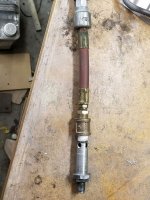I took apart an old pressure relief valve to better understand them and take the mystery out because I really do not know how they work. It had an interesting lead washer to seal the adjusting spring assembly and a rubber washer to seal whole unit. There is also another plug with a spring and ball with a copper sealing washer on the large nut.
I am guessing but it looks like there is a check and balance of the oil pressure with the 2 ball and spring assemblies. The lead washer looks like something installed and set at the factory to relieve the oil pressure at a curtain time or pressure. The ball and spring without the adjusting screw does something, but I do not know.
I was trying to figure out the path for the oil and how the oil moves through the filter and into the oil gallery but could not understand the holes inside the unit. Perhaps the other smaller ball and spring open and the oil moves up the gallery with pressure after the filter. Curiosity killed the cat, but can give a small explanation----anyone understand these things?
Steve
I am guessing but it looks like there is a check and balance of the oil pressure with the 2 ball and spring assemblies. The lead washer looks like something installed and set at the factory to relieve the oil pressure at a curtain time or pressure. The ball and spring without the adjusting screw does something, but I do not know.
I was trying to figure out the path for the oil and how the oil moves through the filter and into the oil gallery but could not understand the holes inside the unit. Perhaps the other smaller ball and spring open and the oil moves up the gallery with pressure after the filter. Curiosity killed the cat, but can give a small explanation----anyone understand these things?
Steve

 Hi Guest!
Hi Guest!

 smilie in place of the real @
smilie in place of the real @
 Pretty Please - add it to our Events forum(s) and add to the calendar! >>
Pretty Please - add it to our Events forum(s) and add to the calendar! >> 


